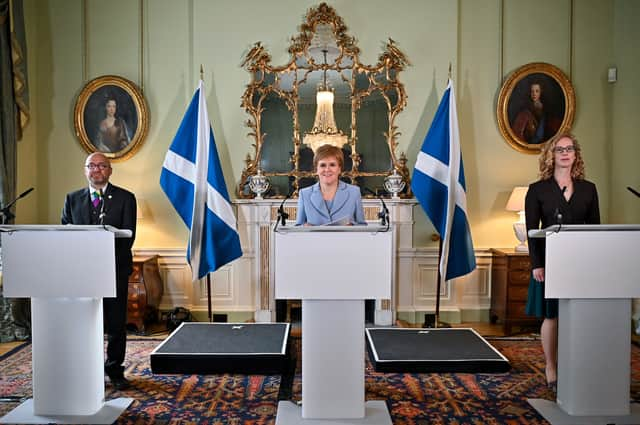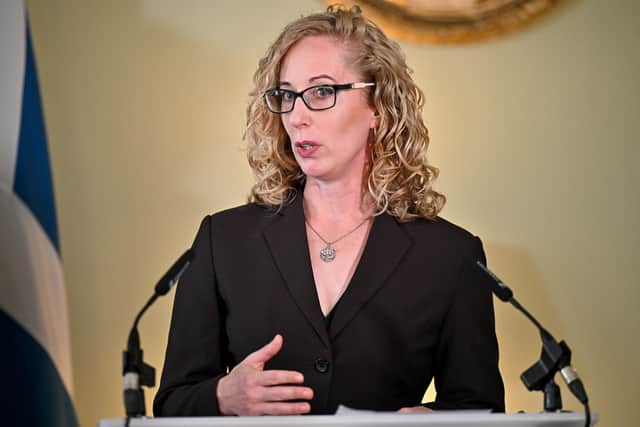SNP and Greens agree power-sharing deal - propose second Scottish independence referendum by 2024
This article contains affiliate links. We may earn a small commission on items purchased through this article, but that does not affect our editorial judgement.


The agreement between the SNP and the Scottish Greens formalises the pro-independence majority in Holyrood, after the SNP fell just one seat short of an overall majority in May’s election.
It also solidifies the timetable on a vote on Scottish independence, with the wording of the deal calling for another referendum in the first half of the parliamentary session, meaning before the end of 2024, if the Covid-19 pandemic has ended.
At-a-glance: 5 key points
- The agreement, which has been negotiated since May between senior members of each party, will put two Green MSPs into Government as ministers.
- The deal covers the vast majority of domestic policy, with 10 areas carved out where the sides could not reach an agreement.
- The role of gross domestic product (GDP) in measuring economic growth, public funding for defence companies, membership of Nato in an independent Scotland and the regulation of selling sex are among areas outside the scope of the agreement.
- There are 10 areas where the SNP and Scottish Greens do not agree and are therefore not expected to support each other. The parties have also agreed to disagree on the matter of fee-paying schools and field sports such as hunting and shooting – a long-running point of difference between the two sides.
- The agreement, which also secures Green support in confidence votes and the budget process – if it is deemed the party has had sufficient input – can be severed by the leaders of either side at any time, but is intended to last for the remainder of this session.
What’s been said?
Advertisement
Hide AdAdvertisement
Hide AdFlanked by Scottish Green co-leaders Lorna Slater and Patrick Harvie at Bute House in Edinburgh, the First Minister said: “Working together to build a greener, fairer, independent Scotland is ground-breaking.
“Ground-breaking in both Scottish and, perhaps even more so, UK politics.”
The First Minister continued: “And yet, despite the magnitude of those challenges – many of them global – today’s politics can too often feel small, polarised, divided and incapable of meeting the moment.
“This agreement is intended to change that – it is about doing politics and governance better.”
Harvie added: “This is indeed a historic moment.
Advertisement
Hide AdAdvertisement
Hide Ad“This deal would see Greens entering Government for the first ever time in Scotland, or anywhere in the UK. And it couldn’t come at a more important time.”
Both the Scottish Conservatives and Scottish Labour said the deal means a coalition government in all but name with the SNP and Greens voting together on the majority of issues.
The Scottish Conservative leader, Douglas Ross, said: “This is a nationalist coalition of chaos focused on splitting up the country and dividing Scotland with another bitter referendum.”
Scottish Labour leader, Anas Sarwar, said: “At long last the SNP and the Greens have formalised the coalition of cuts that has been in action for years. This will come as a surprise to no-one, but it is a disaster for Scotland.”


Why was the deal done?
Advertisement
Hide AdAdvertisement
Hide AdAfter failing to secure an outright majority in the Holyrood elections earlier this year, the SNP need the support of the Greens in the Scottish parliament if they are to see through their policies.
Of course, the most fundamental of SNP policies is Scottish independence, and this is one area where the two parties do agree.
But the lengthy negotiation has also highlighted some of the substantial gaps between the SNP and the Greens, not least on the issue of fossil fuels.
The Scottish Greens have hailed Sturgeon’s “significant change of direction” on the oil and gas industry despite the First Minister refusing to say whether she opposed new oil fields such as Cambo.
Advertisement
Hide AdAdvertisement
Hide AdBut the agreement falls short of any commitment to oppose new oil and gas exploration – a key pledge in the Scottish Green party’s manifesto.
Instead, the policy document offers support for a “pre-production oil and gas licence climate checkpoint review”.
Challenged about potentially being part of a Government that would not oppose further extraction of fossil fuels, Slater insisted her party were “unequivocally against Cambo” but said “our hands are tied”.
It will be interesting to see whether this deal does last the length of this session of the Scottish parliament.
A message from the editor:
Advertisement
Hide AdAdvertisement
Hide AdThank you for reading. NationalWorld is a new national news brand, produced by a team of journalists, editors, video producers and designers who live and work across the UK. Find out more about who’s who in the team, and our editorial values. We want to start a community among our readers, so please follow us on Facebook, Twitter and Instagram, and keep the conversation going. You can also sign up to our newsletters and get a curated selection of our best reads to your inbox every day.
Comment Guidelines
National World encourages reader discussion on our stories. User feedback, insights and back-and-forth exchanges add a rich layer of context to reporting. Please review our Community Guidelines before commenting.